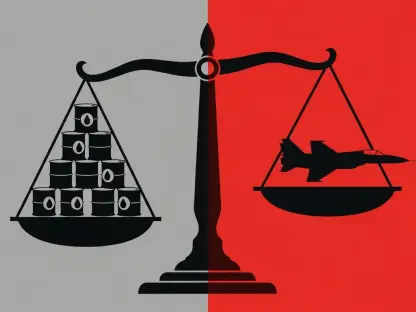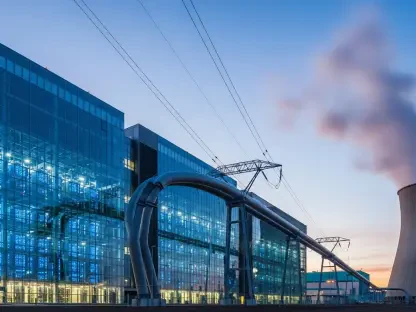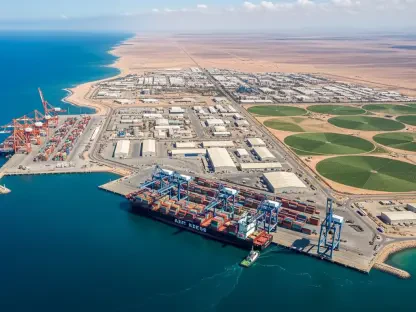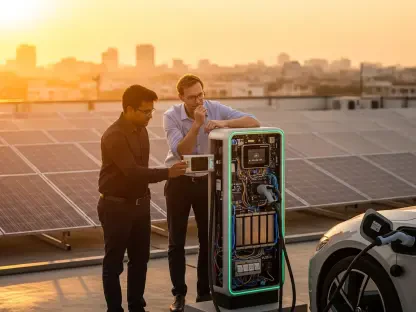The maritime industry stands at a pivotal moment, grappling with the formidable challenge of addressing environmental concerns while maintaining economic viability. This global sector, which currently accounts for a significant portion of worldwide greenhouse gas emissions, is confronted with the urgency of achieving net-zero emissions. Influenced by regulatory frameworks from organizations like the International Maritime Organization (IMO) and the European Union (EU), the shipping industry is undergoing a transformation aimed at reducing its environmental impact. These regulations are not merely suggestive but enforceable, with stringent deadlines and reduction targets set to drive action. As the industry explores a range of solutions, from alternative fuels to advanced technologies, the path to zero emissions reveals both promise and complexity.
Pushing Regulatory Boundaries
IMO and EU’s Emission Mandates
The regulatory environment surrounding maritime emissions is becoming increasingly stringent, as organizations set ambitious targets to curb greenhouse gas emissions. The IMO, a leading entity in global shipping regulations, has proposed mandatory limits, with significant cuts expected within the next few decades. Specifically, shipowners are urged to decrease emissions by 65% by 2040, with plans for regulations to commence by 2028. In tandem, the EU is extending its Emissions Trading Scheme (ETS) towards shipping in 2024 while implementing lifecycle emission-intensity requirements through the FuelEU Maritime regulation. These measures mark a crucial step in the drive for sustainability within the maritime industry, considerably impacting companies and encouraging innovative practices.
These regulatory actions reflect the global commitment to reducing shipping emissions, which currently represent about 3% of worldwide greenhouse gas output. Projections suggest this number could increase to between 5% and 8% by 2050 if effective interventions are not realized. By establishing legally enforceable limits, the IMO and EU aim to align the industry with broader environmental goals, fostering a deep-rooted shift towards greener operations. Climate change concerns are propelling these swift adjustments, positioning regulations as a catalyst for shipping companies to explore sustainable alternatives and integrate advanced technologies, all while managing the multifaceted economic and logistical demands inherent to the sector.
Challenges and Consensus Building
The complexity of adhering to these regulations is multifaceted, involving a combination of economic, technological, and legal considerations. Many industry stakeholders are facing uncertainty as they navigate the intricacies of compliance. Shipowners and operators must evaluate the cost implications of transitioning to low-emission practices, a significant investment that requires careful planning and execution. Despite these challenges, there is an emerging consensus among industry leaders about the necessity of this transition. Conversations across the sector indicate a shared understanding of the urgent need to reduce emissions and mitigate environmental impacts.
The imperative to reach emission goals drives the exploration of alternative fuels and sustainable technologies, fueling collaboration and research initiatives. However, the pathway remains complex due to divergent opinions on the most effective strategies and the extent of investment required. Consensus building is an ongoing process, where stakeholders engage in dialogues to identify feasible solutions that align with regulatory frameworks. These discussions focus on innovation and adaptability, acknowledging that while substantial costs may be involved, the long-term benefits extend beyond ecological preservation, encompassing corporate responsibility and leadership within the global market.
Exploring Alternative Fuels
Potential of Methanol and Ammonia
As the shipping industry seeks to meet stringent emission targets, alternative fuels are emerging as pivotal components of the transition strategy. Among these, methanol and ammonia are gaining traction, each offering distinct advantages and challenges. Methanol-powered vessels, exemplifying a feasible approach, boast dual-fuel engines that cater to the industry’s immediate needs and long-term sustainability ambitions. Companies like Maersk are actively investing in methanol technology, focusing on dual-fuel vessels as viable solutions to navigating regulatory demands without compromising operational efficacy.
Ammonia, while promising, warrants careful consideration due to its inherent safety and toxicity concerns. Despite these challenges, ammonia stands out in demonstration projects such as the Green Pioneer, which showcase the fuel’s potential in reducing maritime emissions. Stakeholders within the shipping value chain emphasize the need for scalable zero-emission fuels to account for a significant portion of the sector’s energy usage in just five years. Collaborative endeavors aim to overcome obstacles related to safe handling, production, and distribution of ammonia, thereby fostering robust solutions that align with emission goals and operational realities.
Biofuels and Their Sustainability
Biofuels are steadily gaining recognition within the maritime sector due to their ability to integrate seamlessly into existing infrastructure. Unlike other alternative fuels, biofuels demand limited changes to current systems, offering practical and immediate solutions. However, sustainability concerns related to feedstock sourcing persist, particularly regarding lifecycle emissions. Palm and soy-derived biofuels face scrutiny due to indirect impacts such as deforestation, which may undermine their environmental benefits. This complexity calls for a careful evaluation of biofuel sources and their ecological ramifications.
Despite these challenges, industry leaders like Nestlé are championing biofuel initiatives, recognizing their potential in curbing emissions while supporting existing maritime operations. This approach is underscored by a commitment to advancing sustainability metrics and addressing feedstock concerns through responsible sourcing. As the sector remains focused on reducing its environmental footprint, biofuels represent a pragmatic avenue towards emission reductions, albeit with considerations for broader ecological impacts.
Advancements in Technology
Wind-Assisted Propulsion Systems
The resurgence of wind as a propelling force within the shipping industry reflects a blend of innovation with traditional practices, advancing technological endeavors towards greater fuel efficiency. Wind-assisted propulsion systems (WAPS), such as rotor sails and suction wings, offer a modern twist on age-old wind-powered principles. By capturing wind energy to provide additional thrust, these systems can achieve substantial fuel savings, up to 40% in some instances, presenting an effective route to emission reduction.
Countries and companies worldwide are increasingly adopting WAPS as viable alternatives in their fleets, recognizing the immediate benefits in terms of cost-effectiveness and environmental impact. Ports like Rotterdam and Singapore are embracing these technologies, facilitating trials and infrastructure development to support widespread integration. This renewed interest in wind power serves as a testament to the ingenuity and adaptability inherent within the shipping industry, making strides towards sustainable operations while enhancing competitiveness in a global context.
Software and Operational Innovations
Technological advancements extend beyond hardware, encompassing software solutions that drive efficiency and significantly reduce emissions. Sophisticated systems enable smarter navigation and better voyage planning, optimizing routes based on real-time weather and oceanic data for fuel-efficient transit. Sofar Ocean’s high-tech buoy network exemplifies progress in this realm, offering precise forecasting capabilities that empower shipowners to make informed decisions on routing and scheduling.
The financial implications of these software-driven enhancements are substantial, with potential fuel savings up to 15%; this efficiency supports regulatory compliance while minimizing operating costs. Coupled with operational improvements such as hull cleaning, these software initiatives contribute to immediate emissions reductions. The fusion of technology and operations underscores the industry’s commitment to innovation, boosting productivity and environmental stewardship simultaneously. As the maritime sector navigates the complexities associated with zero-emission targets, technological solutions provide tangible progress, propelling the industry towards a sustainable future.
Confronting Market Uncertainties
Challenges with Alternative Fuels
The ambitious trajectory towards achieving net-zero emissions in shipping is marred by a host of uncertainties, particularly concerning alternative fuels. Many of these fuels face hurdles related to cost competitiveness, availability, and regulatory compliance. While the potential of fuels like methanol and ammonia is well-documented, their widespread adoption is hindered by market pragmatism and infrastructural demands. The transition demands considerable investment, as the industry grapples with the economic viability of alternative options against fossil-based counterparts.
The production costs related to renewable electricity further complicate the scenario, rendering e-methanol and similar fuels expensive and challenging to implement on a large scale. Stakeholders remain uncertain about the optimal choices for emissions reduction given the extensive lifespan of ships and fluctuating market dynamics. This complexity requires strategic planning and collaboration, as the industry and regulators continuously explore feasible paths forward. The overarching narrative is one of adaptation, seeking solutions that balance technological innovation with market realities.
Economic Viability and Industry Consensus
The economic viability of potential solutions is integral to sustainable integration, shaping consensus within the maritime community. As companies evaluate the practicality of alternative fuels, economic factors, including fuel costs and long-term investments, are pivotal. Dialogue within industry circles remains robust, with stakeholders collaboratively exploring pathways to compliance that align with market realities. These conversations reflect the complexity of achieving emission targets amidst fluctuating economic landscapes, revealing the multi-layered nature of change within the sector.
Despite prevailing uncertainties, there is growing recognition of the imperative to innovate and adapt. Industry leaders are increasingly considering collaborative approaches to navigate complex challenges and foster consensus around feasible solutions. The shipping community acknowledges that achieving net-zero emissions requires a comprehensive alignment of regulatory, financial, and technological efforts. This nuanced approach, grounded in collaboration and foresight, is central to advancing progress in environmental preservation and sustainable global shipping practices.
Path Forward
The maritime industry is facing tighter regulations on emissions as organizations pursue bold goals to curb greenhouse gases. The International Maritime Organization (IMO), pivotal in setting global shipping standards, has proposed mandatory emissions limits, indicating substantial cuts in the coming decades. Shipowners are advised to slash emissions by 65% come 2040, with regulations envisioned to roll out by 2028. Complementarily, the EU is incorporating the shipping sector into its Emissions Trading Scheme starting in 2024 while introducing emission-intensity criteria via FuelEU Maritime regulation. Such initiatives are pivotal in steering the industry towards sustainability, driving companies to innovate and adapt.
These regulatory measures underscore the global drive to reduce shipping emissions, which currently constitute around 3% of global greenhouse gas emissions. Without proactive measures, forecasts suggest this could rise to between 5% and 8% by 2050. By establishing enforceable limits, the IMO and EU are striving to sync maritime operations with worldwide environmental aspirations, encouraging a shift to eco-friendly practices. The pressing issue of climate change is accelerating these regulations, serving as a motivator for shipping companies to examine sustainable options and employ cutting-edge technologies, all while balancing the intricate economic and logistical challenges of the sector.









